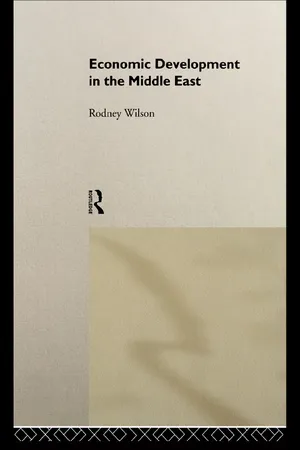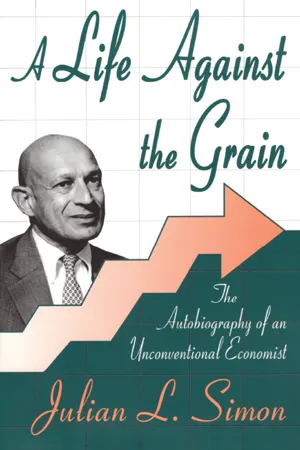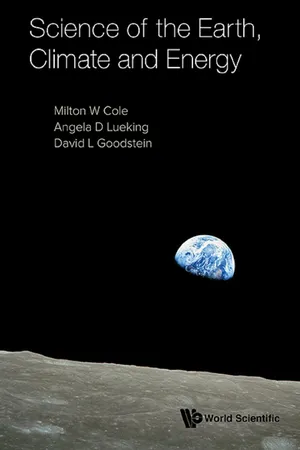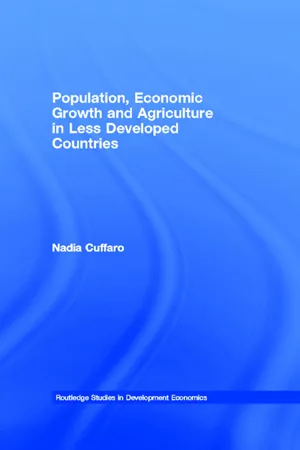Economics
Population Growth
Population growth refers to the increase in the number of individuals in a particular population over a specific period of time. In economics, population growth is a key factor influencing the supply of labor, consumer demand, and overall economic productivity. It can have significant implications for resource allocation, infrastructure development, and social welfare programs.
Written by Perlego with AI-assistance
Related key terms
10 Key excerpts on "Population Growth"
- eBook - ePub
Economic Growth
International Edition
- David Weil(Author)
- 2016(Publication Date)
- Routledge(Publisher)
CHAPTER 4 POPULATION AND ECONOMIC GROWTH With every mouth God sends a pair of hands. —An old saying T his adage provides a good starting point for thinking about the impact of population on economic growth. It makes the point that changes in population affect both the consumption needs of an economy (the number of mouths) and the productive capacity of the economy (the number of hands). If the only thing used to produce output was labor, then the interaction of population and economic growth would not be very interesting: Twice as many people would mean twice as much output, so the size of the population would not affect output per capita. If, however, there are inputs to production other than labor, then adding one person adds one mouth and one pair of hands but no more of the other factors. In per-capita terms, more people will result in less of everything else. This simple observation is the basis for including population in models that attempt to explain income per capita. As we will see, population can be a determinant of income in two different ways. In some contexts the size of the population is important, whereas in others the growth rate is important. Specifically, when we think about the interaction of population with some fixed natural resource, the important aspect is the size of the population. Holding other factors constant, a country with a lot of people relative to the amount of resources will be poorer. But when we think about the interaction of population with a producible input such as capital, then the relevant aspect is the growth rate of population. Of course, over time, the speed with which a population grows is what determines how many people there are. But the words over time make a big difference. Countries can have slow Population Growth and a large population relative to their resources. Or they can have rapid Population Growth but a population that is small relative to their resources. Japan and Chad present examples of these two cases - eBook - ePub
- Rodney Wilson(Author)
- 2002(Publication Date)
- Routledge(Publisher)
4: Population Growth AND EMPLOYMENT
The relationship between Population Growth and economic development has been subject to much debate in both the western world and the Middle East, but as with so much else in economics, no generally accepted conclusions have been reached. There is not even agreement on the fundamental issues of what determines Population Growth and whether there are universal trends. Many development economists believe that the rate of Population Growth reflects the stage of economic development a country has reached, with a tendency for the rate to decline as an outcome of the development process.1 Others assert that Population Growth reflects family preferences, and is determined by cultural and social factors.2 The trends in the western world towards falling rates of growth may therefore not be followed in a region such as the Middle East where Islamic values prevail.THE DEMOGRAPHIC TRANSITION
Figures for population increase represent the difference between birth rates and death rates. High rates of Population Growth may occur as a ‘once-off’ result of a demographic transition when death rates decline, in particular infant mortality rates, but there is a lag before birth rates fall. Several arguments are advanced for this assertion. One is that when infant mortality rates are high, couples have more children so that there is at least a chance that some will survive. Such arguments are based on expectations, probabilities and risk. The demographic transition is a period when expectations are adapted or adjusted, but this takes time.3There are real economic as well as human benefits associated with lower infant mortality. Family lands can be passed on to children when the parents become old. They then assume economic responsibility for their aged parents. There are diminishing returns to labour in relation to fixed family land holdings, however, and excessive numbers of offspring only add to the consumption burden without contributing much to production. It is this type of constraint that may encourage couples to limit family size. - eBook - ePub
Economic Analyses Using The Overlapping Generations Model And General Equilibrium Growth Accounting For The Japanese Economy: Population, Agriculture And Economic Development
Population, Agriculture and Economic Development
- Mitoshi Yamaguchi, Tomoko Kinugasa(Authors)
- 2014(Publication Date)
- WSPC(Publisher)
Therefore, it would not be wise to conclude that there is no relationship between population and economic growth just by observing the correlation which appears in a figure. A more positive way would be to make a factor analysis and to consider both positive and negative effects of Population Growth. Fortunately, we can see many articles recently which observe the interrelationship between population and economic growth. However the causality of interrelationships is not simple as P. Mombelt who states that population and economic growth have a loose and not tight relationship. In this way, a problem of population and economic growth is very complicated in character and we cannot consider a too simple causality for them. However, it is our duty to make a further research and solve these complicated causalities. We economists have to use more energies for studying these problems, as Hazledine and Moreland [1977] state. In this chapter, we first consider the effects of Population Growth on the economy. Second, we consider the effects of the economy on population. Third, we consider the interrelationships between population and economy.1. Effect of Population Growth on Economy
In order to observe the effect of Population Growth on the economy, Coale and Hoover [1958] considered the items of population, the growth rate of population and age distribution. Yasuba [1969] also made the same kind of analysis. However, a better way would be to see how Population Growth was brought about to see the factors which contributed to Population Growth. For Population Growth, we have the following equation:where P denotes population, B birth, D death, IM and OM immigration and emigration. Therefore, it would be enough to see the effect of the right-hand side items in Eq. (6.1) in order to see the Population Growth’s effect on the economy. P (t - eBook - ePub
Exploring Environmental Issues
An Integrated Approach
- David D. Kemp(Author)
- 2004(Publication Date)
- Routledge(Publisher)
4 Demography and World Population Growth
After reading this chapter you should be familiar with the following concepts and terms:age-specific fertility rate exponential growth population (ASFR) family planning population planning agricultural revolution fecundity population projections arithmetic progression fertility r-strategists baby boom fuelwood rate of natural increase birth control general fertility rate (GFR) (RNI) carrying capacity geometric progression renewable resources contraceptive pill gestation replacement fertility rate crude birth rate (CBR) immigration (RFR) crude death rate (CDR) industrial revolution replacement migration demographic transition K-strategists total fertility rate (TFR) model migration zero Population Growth doubling time mortality (ZPG) emigration non-renewable resources POPULATION ECOLOGY
A population is a group of individuals, usually of the same species, occupying a specific area. In the case of the human species the area involved is effectively the entire earth, but human population distribution is uneven. Although humans have developed a remarkable ability to adapt to different environmental conditions and to manipulate environments to meet their ends, some regions remain largely unpopulated. Empty spaces such as those in the Arctic and Antarctic, the deserts of Africa and Asia and the mountainous regions of all the continents, for example, are not unaffected by human activities, but in population numbers they contrast sharply with adjacent more populous regions.CARRYING CAPACITY
In these parts of the earth thinly populated by humans, the population of other species tends to be low also, reflecting the limited resources available to support life. In ecological terms, the carrying capacity of these areas is low. This concept, linking population numbers with the availability of natural resources, originated in ecology, but it is now considered too simplistic for many ecological situations. It continues to be used in conservation ecology and ecological economics, however, and in consideration of relationships between society and the environment (Turner II and Keys 2002). Carrying capacity is a measure of the maximum number of organisms that can be supported in a particular environment, and under natural conditions it represents a theoretical equilibrium state within a dynamic system. If the species in an area are below carrying capacity, for example, populations will tend to increase until some form of balance is reached with the resources available. If the carrying capacity is exceeded, because of the rapid growth in the number of organisms in the ecosystem, for example, there will be insufficient resources to support the excess population, and numbers will decline until equilibrium between the resource base and the population is re-established. Typically, the population fluctuates above and below the level of the carrying capacity before it eventually approaches equilibrium again (Figure 4.1 - eBook - ePub
A Life against the Grain
The Autobiography of an Unconventional Economist
- Julian L. Simon(Author)
- 2018(Publication Date)
- Routledge(Publisher)
More than a century ago, Frederic Bastiat’s famous essay, “What is Seen and What is Not Seen,” taught that economic policy analysis frequently is led into error by disregarding effects which are “unseen” because they are remote either in time or in causal nexus. Population economics requires the long view even more than do most other fields in economics, if for no other reason than that two decades must pass following the birth of a child before the important effects of that child begin to manifest themselves, effects that are easy to overlook when focusing attention on the costs incurred during childhood. Yet the field of population economics perversely has mostly stayed in the self-imposed straitjacket of short-run analysis, the “commonsense” period that so appeals to journalists; that short-run analysis boils down to the deduction that more people sharing the same output, or the same land and tools, implies less output per person.Though the day-to-day work I have done in population economics has been intended to produce new knowledge by using technical analysis of models and data, the conclusions often have emerged as implicit criticisms of faulty thinking, especially the bad thinking that people consider to be “common sense” (for example, there must be a limit to agricultural production).Since World War II, the fallacy of focusing on the short-run effects of Population Growth has caused (or allowed) such institutions as the World Bank, the U.S. State Department’s Agency for International Development (AID), the United Nations Fund for Population Activities (UNFPA), and the environmental organizations to mis-analyze such world development problems as supplies of natural resources, starving children, illiteracy, pollution, and slow growth. Because these institutions have focused their attention on Population Growth, they have not recognized that the key factor in a country’s economic development is its economic and political system. The centrality of the economic-political structure of a country is no longer the subject only of theory and ideology but now has been demonstrated conclusively by empirical analysis. This misplaced attention to Population Growth has resulted in disastrously unsound economic advice being given to developing nations. - eBook - ePub
- Milton W Cole, Angela D Lueking, David L Goodstein(Authors)
- 2018(Publication Date)
- WSPC(Publisher)
zero-sum game, insofar as the total “pie” is fixed in size, while the number of pieces and their sizes are variable; what one person gains (say, a larger slice) is what the other pie-eaters lose. As with many simple statements, some future-forecasters regard the fixed supply model as a valuable takeoff point, while others regard the model’s assumption as naïve and irrelevant to realistic predictions.Among many possible questions concerning population, we focus on these: •How has Earth’s human population changed over the past centuries? •What factors determine Population Growth (or decline)? •Is there a maximum possible human population? •How is Population Growth related to economic well-being?These questions, and many others, lie within the domain of demography ; researchers exploring this subject are sometimes called population scientists . It is evident that quite diverse subjects are involved in this interdisciplinary field, including agriculture, anthropology, economics, epidemiology, history, medicine, psychology and sociology.Is the subject of Population Growth important? A recent survey4 of scientists in the United States asked them whether the following assertion is valid: Growing world population will be a major problem. The scientists answered “yes” overwhelmingly (82%). The U.S. population, as a whole, was less convinced of this problem’s importance; about 59% answered “yes” to the question. This topic’s presence in the book is due its importance for World economics, especially energy production and use. As the population of the world increases, the consumption of energy will likely5 - eBook - ePub
- Gérard Roland(Author)
- 2016(Publication Date)
- Routledge(Publisher)
Source : United Nations, http://esa.un.org/wpp/Excel-Data/population.htm. Reprinted with the permission of the United Nations.Figures 3.1 through 3.4 raise various questions. Why was Population Growth so low until the last 2 centuries and why did it accelerate so much after the Industrial Revolution? One simple answer is that agricultural, economic, and technological progress has increased living standards and increased food supplies, making it possible to sustain a larger population on the planet. However, this cannot be the whole answer. If this were the case, the richest countries would have higher Population Growth rates than poor countries, but in the last 50 years the opposite has happened. Why then has Population Growth been highest in the poor regions of the world and lowest in the developed regions? Finally, why have we seen a reduction in Population Growth everywhere in the world in recent decades? To answer these questions accurately, we need to look closely at the determinants of Population Growth.The Determinants of Population Growth
We begin our discussion of the determinants of Population Growth with some basic demographic vocabulary. We then examine the dynamics of Population Growth based on demographic variables.Fertility, Mortality, and Birth and Death Rates
Population Growth is largely determined by how many people enter and exit a population in a given time period.Age-specific mortality ratesare the percentage of deaths in a particular age group, andage-specific fertility ratesare the number of children born to a woman of a certain age. While mortality rates are counted at any age, fertility rates are only counted for women’s childbearing ages, which are generally considered to be 15–44. Thetotal fertility ratein a country is the average number of children born to a woman of childbearing age.Thebirth rateis the number of babies born each year in a country per 1,000 inhabitants. Thedeath rateis the number of deaths each year per 1,000 inhabitants. A country’sPopulation Growth rateis the difference between the birth rate and the death rate (we divide the birth and death rates by 10 to get a percentage growth rate). We must adjust this figure for thenet migration rate, the difference between the number of persons entering and leaving a country per 1,000 inhabitants.1 - eBook - ePub
Development Economics
Theory and Practice
- Alain de Janvry, Elisabeth Sadoulet(Authors)
- 2021(Publication Date)
- Routledge(Publisher)
Chapter ElevenPopulation and Development
Population Growth is both an asset and a liability for development. It is an asset in that a growing population is a source of youthful labor, social security contributions, and expanding markets. At the household level, children are sources of income and protection for their parents. Poor people typically prefer to have larger numbers of children, as both a choice and a necessity. But they are also a liability. From a simple arithmetical standpoint, Population Growth subtracts from GDP growth in determining growth in per capita income. It also tends to be a source of declining land per capita, food insecurity, environmental degradation, congestion externalities, and urban blight as well as a drain on public goods and services. There are both positive and normative questions associated with Population Growth. Positive questions include: What are the determinants of fertility behavior? Why do countries go through a demographic transition with a phase of exploding Population Growth? Why is there a decline in Population Growth as per capita income rises? How do countries benefit from a one-time demographic dividend as fertility declines while the share of elderly people in the population is still relatively low? Normative questions include: How can we reduce Population Growth if it is deemed excessive? If contraception is the main instrument to reduce fertility, when is it more important to focus on the supply side and when on the demand side of contraception?Our thesis in this chapter is that children fulfill three functions for parents: they are sources of income, protection, and satisfaction. The transition from high to low fertility—the demographic transition—is associated with children losing their income and protection functions for parents, maintaining their universal satisfaction function increasingly through quality as opposed to quantity. Understanding the determinants of fertility is key to designing population policy. With world population reaching 7.7 in 2019 and predicted to reach 9.7 billion in 2050 and nearly 11 billion in 2100 (UN Department for Economic and Social Affairs, 2019), population policy is a key, yet much neglected, aspect of international economic development. - Nadia Cuffaro(Author)
- 2003(Publication Date)
- Routledge(Publisher)
Point e, with zero growth of population and a given standard of living, is a stable equilibrium, in the sense that if either population or the real wage assume a value different from w* and p* this would set in motion a mechanism which tends to restore the original equilibrium. For example, a larger population would reduce the real wage, and cause a decline in the birth rate and an increase in the death rate, bringing the system back towards e. Population is endogenous in a sense that is close to the one found in biological models of animal populations, where food supplies or predator population limit the size of the population. Malthus – and the classical economists in general – viewed population dynamics – its fertility and mortality – as elements of a system that includes the size of the population in relation to the means of subsistence. In this system we look for feedback between population levels and population change. This Classical approach is quite remote from modern demographic theory of population change, which focuses on detailed analysis of each vital rate in isolation from population size. However, it is the way many anthropologists view prehistoric population dynamics, the way many social historians view historical population change, and the way biologists view animal populations. It lies behind the prescriptions of ecologists and environmentalists for contemporary population limitation. (Lee 1997: 1064–1065) Figure 2.1 The Malthus model. Source : Weir (1988) This approach is very different from the one adopted in the recent literature on the economics of the family, discussed in the next chapter- Frederic Y M Wan(Author)
- 2017(Publication Date)
- WSPC(Publisher)
Part 1
Growth of a Population
Passage contains an image
Chapter 2
Evolution and Equilibrium
2.1 Growth without Immigration
2.1.1 Population size dependent growth rates
As indicated earlier, the goal here is to use a simple problem to begin illustrating the mathematical modeling process. We do so by modeling the familiar growth of human population on Earth. Typically, mathematical modeling is prompted by the modeler’s quest for some information about a phenomenon. The human population on Earth has grown from 4 billions in 1974 to 7 billions by 2011. Naturally, we are concerned about future growth and want to know how the population size will change with time.To quantify the evolution of the human population, let y(t) be the population size at time t. Size may be measured by the number of individuals or tonnage of total biomass. Time may be measured in seconds, minutes, hours, days or years from some reference time. To answer by mathematical modeling the question how does the population size evolves with time, we need to formulate some mathematical relation(s) about y(t) on the basis of known scientific principle (such as Newton’s law in physics for motion of mass particles). Unfortunately, there is no equivalence of Newton’s law in biology that governs and regulates Population Growth. In that case, the modeler would have to adopt some reasonable assumptions (postulates) for the phenomenon on hand based on available data and general observations. For a first model, we wish to avoid plunging into highly technical area of statistical analysis of available data or the complex relations of birth and death processes. Instead, we start with a simple phenomenological model of Population Growth.For this simple first model, we should not (and cannot) make assumptions on the size of the population at any future time y(t), since that is what we want to deduce from the model. This forces us to focus on the next level of observable, the change of the population with time. With the human population on Earth changing in fractions of a second (as can be seen from the U.S. Department of Commerce website on the U.S. and World population clock [31 ]), it is not unreasonable to think of the two variables y and t as continuous variables if we measure time in years and size in tons of biomass or billions of individuals. In that case, we may work with the instantaneous rate of change of the Earth’s (human) population dy/dt in developing our mathematical model. In fact, this volume is concerned mainly with phenomena that can be modeled by relations involving instantaneous rates of change. When the rate of change involved is with respect to time, such models are known as dynamical systems
Learn about this page
Index pages curate the most relevant extracts from our library of academic textbooks. They’ve been created using an in-house natural language model (NLM), each adding context and meaning to key research topics.









